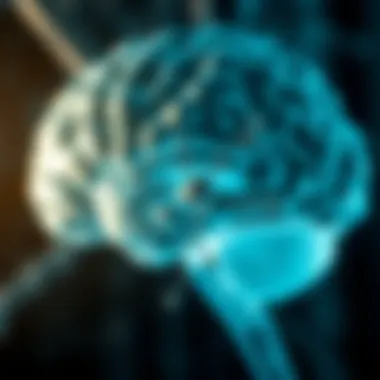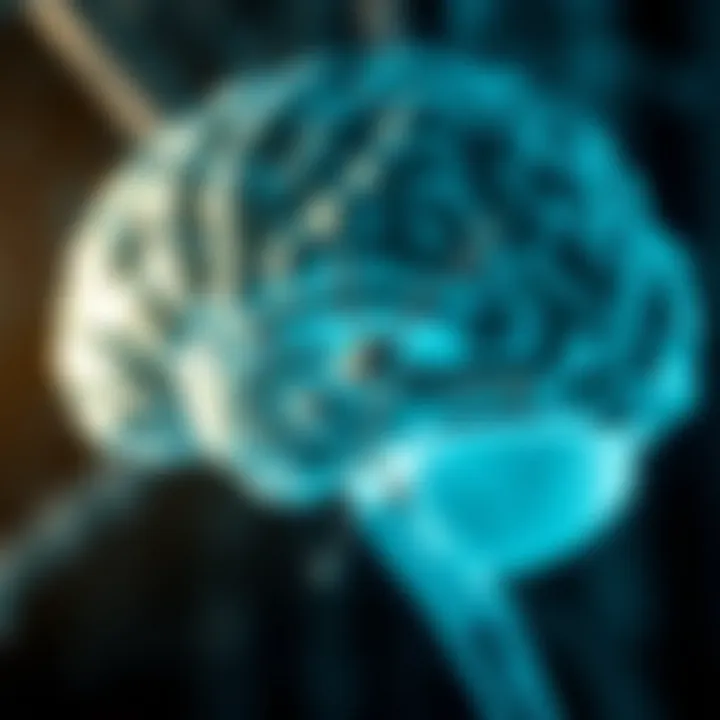Exploring Amyloid: Insights from the Mayo Clinic


Intro
In recent years, the spotlight on amyloid proteins has intensified, and for good reason. Their complex interplay with various physiological processes has now become a focal point for researchers at the Mayo Clinic. Understanding amyloid's role in health and disease opens doors to new therapeutic avenues, particularly in the realms of neurodegeneration and systemic conditions. This article aims to shed light on how amyloid proteins function within the body and how ongoing research is unraveling their significance.
The Mayo Clinic has done extensive work in the field, providing invaluable insights into amyloid's impact on conditions like Alzheimer's disease and systemic amyloidosis. As researchers uncover more about its biochemical properties, they are shifting paradigms in diagnosis and treatment. The information presented here reflects not just scientific inquiry but also a commitment to improving patient care through enhanced understanding of amyloid.
Each section will explore different facets of amyloid, including recent findings from the Mayo Clinic. As we delve deeper, the intention is to provide clarity and foster a greater appreciation for this complex protein, bridging the gap between research and practical application in healthcare.
Intro to Amyloid Proteins
Amyloid proteins have garnered considerable attention in academia and clinical settings, owing to their intricate role in a variety of health conditions. This section aims to lay the groundwork for understanding these fascinating biological entities, explaining their significance, biochemical characteristics, and historical context. Grasping the fundamentals of amyloid proteins serves as a launching pad for delving deeper into their implications in diseases such as Alzheimer's and systemic amyloidosis.
The relevance of amyloid proteins transcends mere biological curiosity; they symbolize a puzzling intersection where protein science meets clinical outcome. For students, researchers, educators, and professionals, apprehending the nature of amyloids opens doors to not only enhanced academic knowledge but also potential therapeutic innovations. Understanding the definition and biochemical nature of amyloid will underscore its complexities, while examining its historical development will shine a light on how perceptions have evolved over time.
"The study of amyloid proteins is not just about understanding a disease; it's about grasping the very essence of cellular malfunction and the body's response to it."
Definition and Biochemical Nature of Amyloid
Amyloid refers to abnormal protein aggregates that accumulate in various tissues and organs, leading to significant health issues. From a biochemical perspective, amyloids are typically characterized by their fibrillar structure, which is the result of misfolding of specific proteins. This misfolding often results in changes to the protein's structure, altering its functional capabilities and causing toxicity to surrounding tissues. In essence, these proteins do a complete one-eighty, morphing into forms that are not only non-functional but also detrimental.
To visualize this, imagine a well-orchestrated symphony where every musician hits the right note; amyloids represent that one rogue musician who goes off-key, throwing the entire performance into chaos. The formation of these aggregates, better known as fibrils, is driven by the process of fibrillogenesis, which is often influenced by varying factors such as genetic predisposition and environmental triggers. The aggregation typically involves a conformational change, encouraging normal proteins to follow suit, ultimately snowballing into larger deposits that can wreak havoc on organ systems.
Historical Perspectives on Amyloid Research
The narrative of amyloid research extends back to the late 19th century, when researchers first observed these peculiar protein deposits under the microscope. Initially thought to be akin to starch (hence the term "amyloid", derived from the Greek word for starch), it wasn't until the mid-20th century that the true nature of these proteins began to unfold.
Notable milestones in amyloid research include the identification of amyloid beta as a hallmark of Alzheimer's disease in the late 1970s. As scientific techniques advanced, such as mass spectrometry and immunohistochemistry, researchers started to piece together the multifaceted role of amyloids in various clinical contexts.
Consider the shift in paradigm from viewing amyloids solely as pathological entities to recognizing their functional complexities in health and disease. This evolution of thought underscores the importance of revisiting historical findings while integrating new methodologies and insights. The past informs the present, allowing for continued innovation in detection and treatment strategies that promise to reshape our understanding moving forward.
Types of Amyloid Deposits
Understanding the types of amyloid deposits is crucial in grasping how these proteins can profoundly impact human health. By dissecting the specific types of amyloid, we illuminate their roles in various diseases, offering insights that can lead researchers and physicians down novel paths in treatment and diagnosis.
Amyloid Beta in Alzheimer's Disease
Amyloid beta is a prime suspect in the pathology of Alzheimer’s disease. This peptide fragment, deriving from the amyloid precursor protein, aggregates to form plaques found in the brains of those affected by the condition. The accumulation of amyloid beta disrupts neuronal communication and triggers inflammatory responses, exacerbating the neurodegeneration that characterizes Alzheimer’s.
In recent years, much has been unveiled about how these plaques correlate with memory loss and cognitive decline. For instance, studies have shown that high levels of amyloid beta in the brain can often be detected years before obvious symptoms manifest. This implicates a crucial window for potential early interventions aimed at preventing or delaying the onset of dementia.
"Early intervention is key; a stitch in time saves nine." This old adage rings true, especially in the context of Alzheimer’s where proactive measures might stave off drastic mental decline.
Amyloidosis and Systemic Effects
Amyloidosis refers to a group of diseases characterized by the abnormal deposition of amyloid proteins in tissues and organs. This accumulation can lead to various systemic effects, as the deposits interfere with normal function. Notably, organs such as the heart, kidneys, and liver can be severely impacted.
There are primarily two types of systemic amyloidosis: AL amyloidosis, originating from immunoglobulin light chains, and AA amyloidosis, secondary to chronic inflammatory diseases. The symptoms often depend on the organs affected and can range from fatigue and weakness to more severe conditions such as heart failure or kidney dysfunction.
The implications of systemic amyloidosis are far-reaching. Management often requires not just treating the amyloidosis itself, but addressing the underlying causes, like inflammatory diseases or cancers, which further complicates patient care.
Transthyretin Amyloidosis: An Overview
Transthyretin amyloidosis arises from the misfolding of transthyretin, a protein that carries thyroid hormones and retinol in the bloodstream. This type of amyloidosis can be hereditary or acquired, leading to significant clinical diversity. Families with a hereditary disposition often show early-onset symptoms, affecting younger patients with cardiac issues or neurological complications.
Acquired forms typically emerge in older adults, presenting itself with symptoms that may mimic other age-related conditions, making it difficult to diagnose promptly. The growing recognition of transthyretin amyloidosis as a potential masquerader of heart disease has led to increased testing and awareness.


Delving into these diverse amyloid deposits not only deepens our understanding but also sheds light on the critical links between specific types of amyloid and their respective diseases. This, in itself, is a vital step toward developing targeted therapies and improving patient outcomes.
Amyloid Pathogenesis
Understanding amyloid pathogenesis is critical in unraveling the complexities of amyloid-related diseases. This section discusses how amyloid proteins misfold and accumulate, leading to varying health consequences. The study of pathogenesis goes hand in hand with identifying strategies for early diagnosis and treatment.
Formation and Fibrillogenesis of Amyloid
The formation of amyloid begins with protein misfolding. Usually, proteins fold into specific shapes necessary for their function. However, conditions can lead them down a slippery slope, resulting in aggregation. This process, often termed fibrillogenesis, involves the conversion of soluble proteins into insoluble aggregates.
Key stages include:
- Nucleation: Small aggregates form, serving as a seed.
- Growth: These seeds grow by the addition of more misfolded proteins.
- Mature Fibrils: Eventually, the fibrils become stable, leading to tissue deposition and associated health risks.
Once deposited, these amyloid fibrils disrupt normal cellular functions, prompting inflammation and damage. Researchers at the Mayo Clinic demonstrate that understanding these stages can help direct more effective screening and therapeutic approaches.
Genetic Factors Influencing Amyloidosis
Genetics plays a substantial role in determining the likelihood of developing amyloid-related conditions. From familial amyloidosis caused by mutations in specific genes to sporadic forms of the disease, the genetic background influences how proteins misfold and aggregate.
Notably, mutations in the transthyretin gene have been linked to hereditary forms of amyloidosis. In addition, but not limited to:
- Amyloid Precursor Protein (APP): Variants can contribute to Alzheimer's disease.
- APOE Gene: The presence of the APOE4 allele can increase amyloid-beta deposition.
Understanding these genetic contributions offers insights into individualized treatment plans. Genetic testing may help identify at-risk individuals, allowing early intervention or monitoring strategies.
Environmental Triggers and Amyloidogenesis
Environmental factors also play a vital role in amyloid formation. While genetic predispositions set the stage, environmental influences can tip the balance toward amyloidogenesis. Some of these triggers include:
- Age: As one ages, protein homeostasis declines. This can lead to an increased risk of amyloid diseases.
- Chronic Inflammation: Long-standing inflammatory conditions can predispose individuals to amyloid deposition believe it or not.
- Diet and Lifestyle Factors: Diet rich in processed foods or high sugar intake can exacerbate protein misfolding.
The Mayo Clinic research highlighted that managing these environmental risk factors can not only help in preventing amyloidosis but also improve overall quality of life among patients.
In summary, understanding the details of amyloid pathogenesis—focusing on protein formation, genetic susceptibilities, and environmental contributions—provides a comprehensive view of the mechanism behind these diseases. This knowledge is essential for developing diagnostics and therapies that can meaningfully impact health outcomes.
Diagnostic Approaches in Amyloid Disorders
Understanding the diagnostic approaches in amyloid disorders is crucial, as accurate and timely diagnosis plays a significant role in the management of these complex conditions. Amyloid proteins, when improperly folded, can accumulate in various tissues, leading to substantial health implications ranging from neurodegenerative diseases to systemic amyloidosis. The nature of these conditions demands that healthcare providers utilize a mix of traditional and innovative diagnostic techniques, ensuring that patients receive the right intervention at the right time.
Histological Techniques for Detection
Histological techniques remain a cornerstone in the diagnosis of amyloid disorders. These methods involve examining tissue samples under a microscope after they have been stained specifically to highlight amyloid deposits. The classic treatment is the use of Congo red staining, which results in a characteristic apple-green birefringence under polarized light. This technique is advantageous due to its high specificity for amyloid proteins and is routinely employed in both research and clinical settings.
Furthermore, more advanced histological approaches are emerging, including immunohistochemistry, which utilizes antibodies directed against specific amyloid proteins. This method can reveal the type of amyloid present, which is vital for determining the appropriate treatment plan.
It's noteworthy that a skilled pathologist plays a critical role in interpreting histological results, as amyloid deposits can be subtle, often found in small samples such as biopsies of abdominal fat or bone marrow. Such nuanced techniques ensure that patients with conditions like AL amyloidosis receive earlier treatment, ultimately leading to better outcomes.
Imaging Modalities in Amyloid Diagnosis
As technology advances, imaging modalities have carved a niche in diagnosing amyloid disorders. Various imaging techniques can provide insights into amyloid burden throughout different organs. Cardiac amyloidosis, for instance, can be evaluated using echocardiography to assess the heart's structure and function, while cardiac MRI can offer a more detailed view of amyloid infiltration in the heart muscle.
Positron Emission Tomography (PET) has recently gained traction due to its ability to visualize amyloid deposits non-invasively. Specific tracers like Pittsburgh Compound B bind specifically to amyloid in the brain and can help in assessing conditions like Alzheimer’s disease. These imaging tests not only assist in diagnosis but also in evaluating disease progression and response to therapy, ultimately shaping personalized treatment plans.
In summary, the incorporation of imaging into diagnostic workflows has added depth to our understanding of amyloid diseases by providing holistic insights that histological methods alone might not capture.
Biomarkers and Blood Tests


Biomarkers and blood tests are an emerging frontier in the diagnostic landscape of amyloid disorders. With ongoing research, specific biomarkers, such as serum free light chains and N-terminal pro B-type natriuretic peptide (NT-proBNP), have shown promise in diagnosing and monitoring systemic amyloidosis. Their levels can correlate with disease severity, thus aiding clinicians in both diagnosis and tracking treatment responses.
Innovations in proteomics have also facilitated the identification of novel biomarkers that could indicate amyloid presence more accurately. Blood tests, being less invasive than other methods, allow for regular monitoring, which is particularly crucial for patients who might experience shifts in their amyloid burden over time.
In addition to these, liquid biopsy techniques are beginning to gain acceptance. These methods might detect specific tumor-derived biomarkers in the blood associated with certain types of amyloid diseases, further personalizing care strategies for optimal patient management.
Overall, the integration of biomarkers and blood testing into clinical practice represents a significant leap forward, enhancing diagnostic precision and paving the way for more tailored therapeutic interventions.
"Early and accurate diagnosis of amyloid disorders facilitates timely therapeutic interventions, potentially altering disease trajectories and improving patient outcomes."
Therapeutic Strategies for Amyloid-Related Diseases
The exploration of therapeutic strategies for amyloid-related diseases is fundamental, especially considering the rising prevalence of conditions such as Alzheimer's disease and systemic amyloidosis. Recognizing how to approach these complex diseases involves understanding the multifaceted nature of amyloid proteins and their interactions within biological systems. The benefits of effective therapeutic strategies can not only improve patient outcomes but also pave the way for more personalized medicine. In an era where treatment has transitioned towards individualized care, therapies targeting the specific pathways of amyloid formation and accumulation are critical. The following sections delve into the current pharmacological approaches, emerging treatments, and lifestyle modifications pertinent to managing amyloid-related diseases.
Current Pharmacological Approaches
Pharmacological therapies aimed at amyloid-related diseases primarily focus on reducing the production or enhancing the clearance of amyloid proteins from tissues. Several drugs are either approved or are under rigorous investigation.
One notable example is Aducanumab, an amyloid-beta-targeting antibody that received conditional approval in 2021 for treating Alzheimer's disease. This drug works by binding to amyloid plaques and facilitating their removal from the brain. In some clinical trials, patients exhibited slowed cognitive decline, although its approval stirred considerable debate about efficacy and appropriate patient selection.
Additionally, Donepezil, Galantamine, and Rivastigmine work to boost acetylcholine levels in the brain, which has beneficial effects on cognition, though these are not specifically targeted at amyloid proteins themselves.
Aside from these, there are also compounds like TAU-031 in the works, which target tau proteins, thereby aiming to address the secondary effects of amyloid pathology and provide a more comprehensive approach to treatment. The investigation into small molecule inhibitors that disrupt amyloid fibril formation or promote their disaggregation is also a promising avenue in pharmacotherapy.
Emerging Treatments and Clinical Trials
The landscape of treatments for amyloid-related diseases is undergoing rapid transformation. Clinical trials explore various avenues, such as monoclonal antibodies and immunotherapies, which provide hope where traditional pharmacological strategies look limited. For instance, studies involving Lecanemab, another monoclonal antibody targeting soluble amyloid-beta, suggest that it may reduce the clinical decline in early Alzheimer’s patients, thus showcasing the potential utility of targeting different amyloid species.
Moreover, biologics are beginning to emerge prominently in ongoing research. Trials are underway to assess their effectiveness in binding to monomeric or oligomeric forms of amyloid, potentially leading to more refined treatment modalities. The incorporation of gene therapies that target cellular mechanisms responsible for amyloid pathology presents a frontier yet to be fully explored, but initial findings are promising.
"The future of treating amyloid-related diseases hinges on integrating new technologies with traditional practices and revising our understanding of neurodegeneration.”
As these therapies progress through various clinical stages, the ultimate goal remains: moving from a one-size-fits-all approach to more tailored strategies that focus on individual patient needs and disease characteristics.
Lifestyle Modifications and Management
While pharmacological approaches play a pivotal role in managing amyloid-related diseases, lifestyle modifications are equally important in supporting overall health and well-being. For individuals facing these issues, adopting a brain-healthy lifestyle can offer complementary benefits.
- Diet: Emphasizing a Mediterranean or DASH diet can be beneficial. Foods rich in omega-3 fatty acids, antioxidants, and dietary fiber not only promote cardiovascular health but may also assist in reducing amyloid burden.
- Physical Activity: Regular exercise has been linked to improved cognitive function. Engaging in aerobic exercises, like walking, swimming, or cycling, can enhance blood flow to the brain and potentially diminish amyloid deposition.
- Cognitive Engagement: Keeping the mind active through puzzles, social interactions, or learning new skills might offer protective effects against cognitive decline. These strategies stimulate neural activity, potentially counteracting amyloid's adverse impacts.
- Stress Management: Chronic stress can exacerbate the progression of neurodegenerative diseases. Techniques such as mindfulness, yoga, or even simple deep-breathing exercises contribute to mental health, further influencing physical health positively.
Case Studies from the Mayo Clinic
The significance of case studies in understanding amyloid protein pathology cannot be overstated. The Mayo Clinic, a leader in both clinical practice and research, offers a wealth of real-world instances that unravel the complexities surrounding amyloid-related diseases. By delving into these specific cases, we gain insights that enhance our grasp of amyloid's impact on patient health and the effectiveness of different treatment modalities. Moreover, these case studies act as critical touchstones for researchers and healthcare professionals, providing practical lessons that extend beyond theoretical knowledge.
Aided by advanced diagnostic techniques and a multidisciplinary approach, Mayo Clinic’s case studies illuminate important facets of amyloid diseases, from symptoms presentation to management strategies. Understanding these cases helps to bridge the gap between laboratory findings and clinical application, allowing for continuous improvement in patient care. Let’s explore some notable findings and outcomes derived from these clinical observations.
Notable Research Findings
Mayo Clinic case studies have contributed significantly to the understanding of amyloid proteins. For example, researchers have documented instances of atypical presentations of transthyretin amyloidosis in patients, which has challenged existing diagnostic norms. These findings have led to an increased awareness and testing for related conditions, reshaping our understanding of how amyloidosis can manifest in distinct patient populations.
Some highlighted findings include:
- Identification of early biomarkers specific to amyloid diseases, allowing for timely intervention.
- Research that elucidates the connection between amyloid deposits and neurodegeneration, paving the way for potential therapeutic approaches.
- Studies showcasing variations in amyloid subtype expressions among different demographics, suggesting a tailored approach to treatment may be necessary.
These discoveries are instrumental in fostering innovation in early diagnosis and intervention strategies which ultimately enhance patient outcomes. They also raise questions about the importance of personalized medicine in treating amyloidosis.


Patient Outcomes and Treatment Efficacy
The analysis of patient outcomes at the Mayo Clinic often reveals a compelling narrative about the efficacy of interventions directed at amyloid-related diseases. The retrospective studies utilize data from various treatment regimens, assessing their effectiveness in real-world scenarios and documenting patient responses.
In several published case reports, patients undergoing novel treatment protocols benefited significantly, showing improvements not only in clinical symptoms but also in quality of life. Notable trends observed include:
- A marked reduction in hospitalization rates among patients receiving comprehensive amyloid management.
- Improved neurological functions in patients with Alzheimer’s disease through tailored pharmacotherapy.
- Enhanced patient satisfaction scores due to the integration of lifestyle modifications alongside pharmacological interventions.
This element of treatment evaluation is pivotal as it underscores the importance of evidence-based practices in clinical settings and emphasizes the ongoing need for research that bridges laboratory developments with patient care.
Ultimately, these findings highlight the Mayo Clinic’s role in setting benchmarks for other institutions, driving future research efforts, and improving therapeutic strategies in the realm of amyloid disorders. The blending of clinical experiences with academic inquiry is crucial for creating a robust platform for future discoveries in amyloid research.
Future Directions in Amyloid Research
Research on amyloid proteins is continuously evolving, highlighting a myriad of unknowns and discoveries. As we delve deeper into the complexities of amyloid, it becomes increasingly clear that the future holds much promise. This segment emphasizes the significance of focusing on future directions in amyloid research, honing in on the unique aspects, advantages, and underlying factors driving this ongoing inquiry.
Innovations in Detection and Therapy
Recent advancements have sparked a wave of innovation in both the detection and treatment of amyloid-related disorders. One of the notable breakthroughs is the development of non-invasive imaging techniques. Using positron emission tomography (PET) scans with amyloid ligands, clinicians can now observe amyloid deposits in living brains. This approach, alongside biomarkers identified in blood and cerebrospinal fluid, provides a clearer picture of disease progression and effective management strategies.
In tandem, therapies targeting amyloid proteins are being evaluated in clinical settings with encouraging results. One such therapy is the use of monoclonal antibodies aimed at amyloid-beta, like Aducanumab. These drugs appear to slow the progression of Alzheimer’s disease by removing problematic deposits. Such therapeutic innovations not only pave new paths for management but also enhance potential quality of life for patients suffering from amyloid-related conditions.
However, while these innovations show promise, they underscore the need for ongoing refinement. Continuous research is vital to determine the long-term efficacy of these treatments and to establish protocols that maximize benefits while minimizing risks. As detection methods improve, so does the necessity for integrative approaches that meld findings from various specialties, thus enriching the overall treatment landscape.
Potential Research Areas and Unanswered Questions
The landscape of amyloid research is filled with fresh avenues to explore and questions seeking resolution. One crucial area is the genetic basis of amyloid disorders. While certain genetic markers have been isolated, much remains to be uncovered about how they interact with environmental factors. This interplay opens the door to myriad research possibilities, such as studying individual predispositions to amyloidosis.
Moreover, understanding the role of amyloid beyond pathology is increasingly critical. For instance, can amyloid proteins play a beneficial role in other cellular processes? Researchers are now asking whether these proteins could be harnessed for therapeutic means, akin to how other proteins may aid in cellular repair or as signaling molecules.
There are still gaps in our knowledge regarding the full range of systemic effects of amyloid deposition. How do varying amyloid types influence an individual’s health, and what are the long-term ramifications of these accumulations? These questions necessitate robust investigations, and encouraging collaboration across disciplines could yield valuable insights.
In summary, future directions in amyloid research hold vast potential. With innovative detection techniques and promising therapeutic strategies on the horizon, it is a pivotal time for the scientific community. The unanswered questions pose challenges but also provide fertile ground for exploration that could transform understanding and treatment of amyloid-associated diseases in the years to come.
"The future belongs to those who believe in the beauty of their dreams."
Thus, by pursuing these critical areas of inquiry, we may one day unlock the full potential of amyloid research, turning possibility into reality.
For further reading on amyloid research, you may explore resources such as National Institutes of Health and Alzheimer's Disease Research Center.
Epilogue
The exploration of amyloid proteins holds significant sway in the landscape of contemporary biomedical research. In this article, we have traversed various facets of amyloid, from its fundamental biochemical characteristics to its intricate role in various diseases, particularly Alzheimer's and systemic amyloidosis. Each finding from the Mayo Clinic has underscored the necessity of understanding amyloid's multifaceted nature and its impact on human health.
Summation of Key Findings
The key findings outlined here summarize the paramount insights gathered throughout our study:
- Biochemical Insights: Amyloid proteins are not mere aberrations but are integral to understanding complex pathologies. Their misfolding and accumulation lead to various diseases—notably neurodegeneration and systemic conditions.
- Diagnostic Innovations: The development of advanced histological techniques, imaging modalities, and biomarker identification has revolutionized the diagnostic landscape, enabling earlier and more precise detection of amyloid-related disorders.
- Therapeutic Progress: Current pharmacological avenues and emerging treatments highlight a proactive approach to managing amyloid diseases, focusing on targeted therapies and lifestyle adjustments that enhance patient outcomes.
These findings not only encapsulate the gravity of amyloid research but also showcase the strides being made in therapeutic strategies, providing a glimpse into the future of amyloid management.
Implications for Future Research and Knowledge Dissemination
Understanding amyloid proteins is a continually evolving frontier, and several implications emerge for future research and dissemination of knowledge:
- Broader Research Horizons: The delineation of genetic factors and environmental triggers invites further investigation into prevention strategies, urging researchers to explore genetic modifications and lifestyle interventions that could preempt amyloid accumulation.
- Community Engagement: Amplifying awareness through educational platforms can empower not only healthcare practitioners but also the general public. Utilizing resources such as Mayo Clinic's outreach programs and academic partnerships can bridge the gap between research and real-world application.
- Collaborative Approaches: Fostering collaborations among institutions and incorporating interdisciplinary strategies may catalyze breakthroughs in detection, treatment, and overall understanding of amyloid’s role in various diseases.
Such efforts can cultivate a deeper comprehension of the intricacies surrounding amyloid, bridging the divide between complex scientific information and public understanding.
"The journey to unravel the mysteries of amyloid is ongoing, yet every insight brings us closer to innovative solutions for those afflicted by related diseases."
The road ahead is not only about uncovering new findings but also redoubling efforts to disseminate knowledge effectively, ensuring that advancements in the field of amyloid research inform therapeutic practices and patient care on a global scale.















